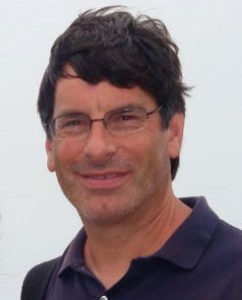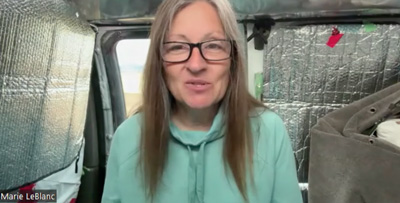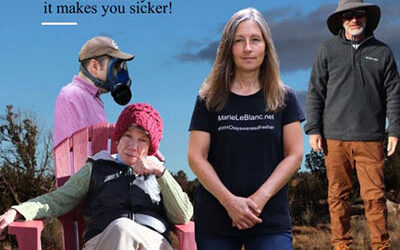Jack Rossi’s memoir of his experience with MCS, being forced outdoors and his insight into the Vermont landscape, health and healing and the fragile planet we inhabit

Introduction
It was after midnight. I got up from my bed in terror. Not terror from a bad dream, but terror from the ever-increasing reality I’d been experiencing over the last several weeks. I couldn’t sleep. My eyes, my skin, the inside of my nose and mouth burned with a needle sharp intensity. My breathing was labored but the air felt toxic so I didn’t know whether to take in more or less. My heart palpitated uncontrollably. I staggered down the dark hall, arms extended like the Frankenstein monster to avoid bumping into a wall. I had no particular destination in mind. I just had to move to get away from the torment. It felt like a burning acid rain fell on me as I continued walking, only I was indoors, not outside.
I wandered through the kitchen, then the living room, guided by the dim glow of a few strategically placed nightlights. Nowhere I went, nor anything I did, seemed to relieve the agony. Finally, returning back through the hall in a futile attempt to find relief, I slumped into the empty lower bunk of my son’s bed. Even though it was a warm July night I pulled the covers over my head and sought a deep, dream-filled sleep; dreams of a world where my body reaped health and comfort from its environment, where the soil, water and air weren’t contaminated with chemicals, and I no longer had to search for safety in the dark.
Multiple Chemical Sensitivity (MSC) is a devastating and often misunderstood illness. In its most severe form it leaves a trail of hopelessness, suffering and isolation. Whether brought on by a single significant chemical exposure or repeated milder exposures over a period of weeks or months, individuals with MCS share one common trait; a multiple symptomatic reaction from exposure to extremely low levels of chemical substances. The symptoms, varying from mildly disturbing to totally disabling, can affect any part of the body. Vigilance and action are the twin bodyguards of a person with MCS; the ability to perceive an impending reaction and the good judgment to remove yourself from the offending environment.
Although MCS is frequently misunderstood and downplayed in seriousness, this condition is becoming better understood by the medical profession and the general public. This growing awareness is partly due to consistent complaints from specific groups of people around particular events, the heavy media coverage these events have received and the research and studies these events have spawned. Two occurrences, the Hurricane Katrina trailers and Gulf War Syndrome deserve mention.
Hurricane Katrina struck New Orleans on the morning of August 29th 2005. The storm and subsequent levee breaks put more than eighty percent of the city underwater, resulting in significant loss of life, communication breakdown, destruction of buildings and roads, civil disturbances and mass evacuation.
In an attempt to house the 300,000 plus homeless residents, the Federal Emergency Management Agency (FEMA) provided newly constructed trailers as temporary living quarters for these people. In leaving the flooded city and entering their new homes, these unknowing evacuees essentially traded a natural disaster for a major health disaster. The inhabitants began suffering from respiratory distress, burning eyes, headaches, lethargy, sinus infections and nosebleeds shortly after taking up residence in the new trailers. Many who remained, and most had no choice but to remain, developed further complications including asthma, nasal and mouth tumors, and in a few instances, death.
The Center for Disease Control and the Sierra Club conducted independent air quality tests and found excessively high concentrations of formaldehyde, a known carcinogen found in many of the materials (particle board, glues, carpeting) used to construct these trailers. The Washington Post cited that many tested trailers “drastically exceeded” the Environmental Protection Agency and National Institute for Occupational Safety and Health’s exposure limits. While there has been some expected disagreement from the trailer manufacturers, the formaldehyde exposure is generally accepted as the cause of the health crisis.
The Persian Gulf War ended in February 1991. Shortly thereafter veteran’s began complaining of vague, inexplicable medical symptoms upon their return including neurological problems, skin lesions, memory loss, headaches, dizziness, muscle and joint pain. After almost two decades of denial by the government and military, or simply placing the blame on psychological trauma, a congressionally mandated panel of medical experts, scientists and military veterans conducted intensive research and concluded that Gulf War Syndrome is a real medical condition.
Their report cited two primary exposure conditions as the most likely major contributors to the illness. The first, in anticipation of chemical attacks on the soldiers, many of them were given the drug, pyridostigmine bromide to increase survival rates from possible nerve gas exposure. Then, to combat desert insects, pesticides were sprayed on troop’s dining areas, tents and clothing.
As a safeguard to less than adequate below ground ventilation, coal miners in the U.S. and U.K. traditionally brought caged canaries down into the mines with them as sentinels. The birds were far more sensitive to dangerous gases like methane and carbon monoxide that could potentially enter into a new seam in the mine, than their human counterparts. As long as the birds continued to sing the miners were safe, but if the bird fell ill or died, it signaled an immediate evacuation of the mine. The expression ‘canary in a coal mine’ has been aptly used to describe a chemically sensitive individual. The coal mine is now the planet and an ever increasing population of human canaries are serving, willingly or not, as the sentinels.
From my personal experience, research and discussion with others with MCS, one salient point emerges: these symptoms are not psychological, but physiological and neurological reactions to toxic chemicals. The rapid infusion of chemicals into our society throughout the twentieth century has completely outpaced any possible genetic modification our bodies could ever manifest to adapt to these threats. These invisible toxins can be found in our food, water and air from where they’re then ingested, breathed or absorbed through the skin, accumulate in our fat cells and steadily increase our body’s toxicity.
Unlike Europe, where the European Union established an environmental policy placing the responsibility on the manufacturer to prove a chemical is safe before release, the United States allows hundreds of new, untested chemicals into production every year. The Toxic Substance Control Act of 1976, did give the Environmental Protection Agency the authority to regulate chemicals but the law was flawed. The Environmental News Service recently reported that the system is in dire need of reform. The legal hurdles of existing law have derailed the system, making it impossible to ban, limit, or even regulate the use of toxic chemicals, and to date, the EPA has only required testing on some 200 of approximately 82,000 chemicals in commerce. An intelligent analysis and restructuring of this system and how we introduce new chemicals into the public domain might be a frontline defense to waiting for the illness and death of innocent people to initiate action.
Fortunately, some of us are paying attention. Smoking has long been banned in public places; lawn care companies are including an organic care option with their services; organic fruit and vegetables are displayed next to conventional produce at mainstream grocery stores; grass-fed, hormone and antibiotic-free beef and poultry is ubiquitous in central Vermont where I live; wool, organic cotton, hemp and bamboo are finding their way into designer clothing; major paint manufacturers are beginning to market low or no-VOC paints; and with the recent publicity around polycarbonate plastic bottles releasing Bisphenol A (BPA), a hormone altering chemical, when heated, stainless steel water bottles and BPA free baby bottles have flooded the market.
That terrible night in the house, aimlessly walking room to room, desperately searching for a safe haven, proved futile. Waking that morning, I realized I could no longer inhabit my house. In only weeks this mysterious condition had struck me with unexpected swiftness, producing devastating chronic symptoms and significant life changes, not the least of which was forcing me outdoors. My house, work place, family center, had become toxic to me.
The experience of having to restructure my life, essentially from the inside out, became my personal journey. I didn’t plan it. I didn’t expect it. If I’d had a choice at the time, I certainly would never have accepted it. The process was painful, slow and unpredictable. Sometimes a day would seem endless. On those days, and there were many, I took the challenges hour by hour, sometimes minute by minute. But along with the pain, isolation and fear, I found strength, courage and healing. I tore a slit in the blinders of predictability that allowed me to see myself as a far more independent and self-reliant being than I had realized, and an integral part of a much larger, co-dependent environment.
With each day I found what I had considered the necessary essentials of modern living: a large home, a full calendar, plentiful furniture, a host of household supplies, a varied wardrobe, electronics, began to loose their importance and served very little purpose in my life. I was astonished at how little I actually needed to contentedly subsist. Survival had little to do with what I had previously considered important – in fact those ‘precious’ possessions were a barrier to truly living life.
Forced outdoors, the subtle shifts in air currents, sun patterns, shadows and cloud formations; the smell of freshly cut grass, wildflowers, decaying leaves, wood smoke; the hundreds of sounds, from the almost indiscernible chafe of dry grass in the breeze to the night-shattering cries of coyotes, previously rendered mute and invisible by a literal wall of lumber and drywall, became as familiar to me as the varied nuances in my own home had been. Each morning, as light gradually overtook darkness and the sound of singing birds built in crescendo, I was gently prodded from sleep. And each night as the air stilled, cooled and darkened, I sought rest. I learned how foreign my relationship with the land, just outside my window, had become. This condition broke something in me, physically and emotionally. This I would restore. But it also broke the illusion of personal limitations and outer dependency. This would drive me.
Immersed in the Vermont landscape, with a newfound inner reliance, I set out to reinvent my life.
read more:
Introduction
Chapter 1 ~ The Wonder Years
Chapter 2 ~ Evolution of an Illness
Chapter 3 ~ Changes
Chapter 6 ~ A New Beginning
 Jack Rossi is principal and owner of Jack Rossi Landscape Architecture, Woodstock, VT, a landscape architectural firm, specializing in sustainable landscape design. He’s also an adjunct professor of landscape architecture and sustainable design at Vermont Technical College and author of the forthcoming book on multiple chemical sensitivity and the environment, InsideOut.
Jack Rossi is principal and owner of Jack Rossi Landscape Architecture, Woodstock, VT, a landscape architectural firm, specializing in sustainable landscape design. He’s also an adjunct professor of landscape architecture and sustainable design at Vermont Technical College and author of the forthcoming book on multiple chemical sensitivity and the environment, InsideOut.










great article. looking forward to the book. there can never be enough education around mcs. i found a great deal of hope in Jack’s story.
j8
I love how he weaves his compelling personal story with history – the best way to educate!
I was glad to read that article…I’m praying for relief from the same disease. hopefully more knowledge will help us all..
…yes and most people don’t understand! They think we are crazy…the burden of proof seems to be on us and then they probably won’t even look if there is proof. I have a scan of my brain and it’s being eaten by chemicals. It’s called (as I remember) toxic brain encelphalophty(sp)